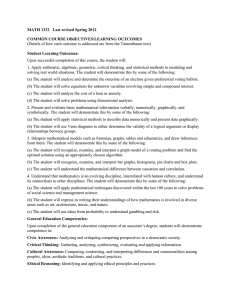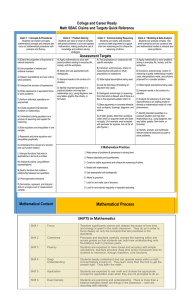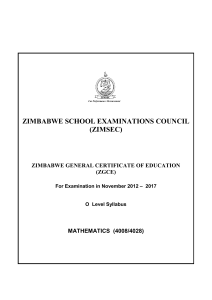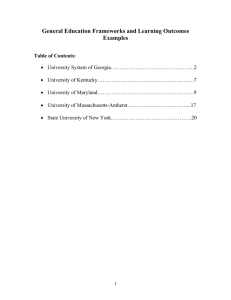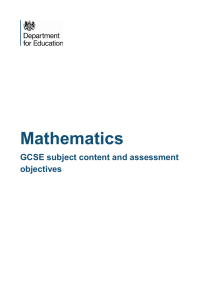1 (Details of how each outcome is addressed are from the... COMMON COURSE OBJECTIVES/LEARNING OUTCOMES
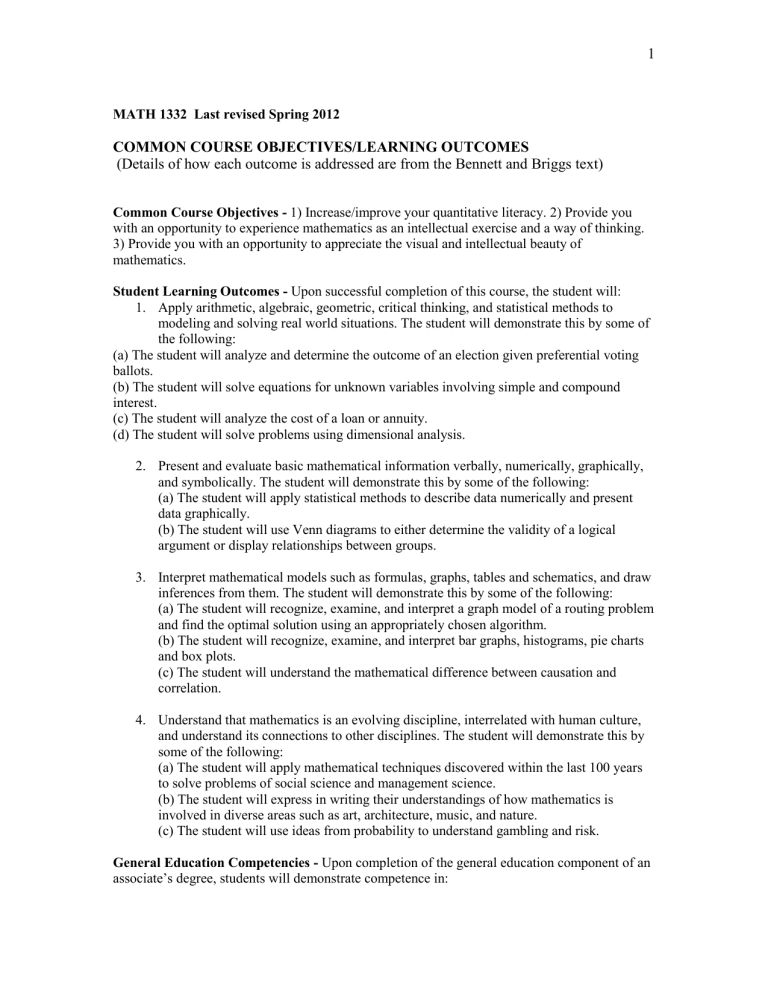
1
MATH 1332 Last revised Spring 2012
COMMON COURSE OBJECTIVES/LEARNING OUTCOMES
(Details of how each outcome is addressed are from the Bennett and Briggs text)
Common Course Objectives - 1) Increase/improve your quantitative literacy. 2) Provide you with an opportunity to experience mathematics as an intellectual exercise and a way of thinking.
3) Provide you with an opportunity to appreciate the visual and intellectual beauty of mathematics.
Student Learning Outcomes - Upon successful completion of this course, the student will:
1.
Apply arithmetic, algebraic, geometric, critical thinking, and statistical methods to modeling and solving real world situations. The student will demonstrate this by some of the following:
(a) The student will analyze and determine the outcome of an election given preferential voting ballots.
(b) The student will solve equations for unknown variables involving simple and compound interest.
(c) The student will analyze the cost of a loan or annuity.
(d) The student will solve problems using dimensional analysis.
2.
Present and evaluate basic mathematical information verbally, numerically, graphically, and symbolically. The student will demonstrate this by some of the following:
(a) The student will apply statistical methods to describe data numerically and present data graphically.
(b) The student will use Venn diagrams to either determine the validity of a logical argument or display relationships between groups.
3.
Interpret mathematical models such as formulas, graphs, tables and schematics, and draw inferences from them. The student will demonstrate this by some of the following:
(a) The student will recognize, examine, and interpret a graph model of a routing problem and find the optimal solution using an appropriately chosen algorithm.
(b) The student will recognize, examine, and interpret bar graphs, histograms, pie charts and box plots.
(c) The student will understand the mathematical difference between causation and correlation.
4.
Understand that mathematics is an evolving discipline, interrelated with human culture, and understand its connections to other disciplines. The student will demonstrate this by some of the following:
(a) The student will apply mathematical techniques discovered within the last 100 years to solve problems of social science and management science.
(b) The student will express in writing their understandings of how mathematics is involved in diverse areas such as art, architecture, music, and nature.
(c) The student will use ideas from probability to understand gambling and risk.
General Education Competencies - Upon completion of the general education component of an associate’s degree, students will demonstrate competence in:
Civic Awareness: Analyzing and critiquing competing perspectives in a democratic society.
Critical Thinking: Gathering, analyzing, synthesizing, evaluating and applying information.
Cultural Awareness: Comparing, contrasting, and interpreting differences and commonalities among peoples, ideas, aesthetic traditions, and cultural practices.
Ethical Reasoning: Identifying and applying ethical principles and practices.
Interpersonal Skills: Interacting collaboratively to achieve common goals.
Life/Personal Skills: Demonstrating effective learning, creative thinking, and personal responsibility.
Quantitative and Empirical Reasoning: Applying mathematical, logical and scientific principles and methods.
Technology Skills: Using appropriate technology to retrieve, manage, analyze, and present information.
Written, Oral and Visual Communication: Communicating effectively, adapting to purpose, structure, audience, and medium
